
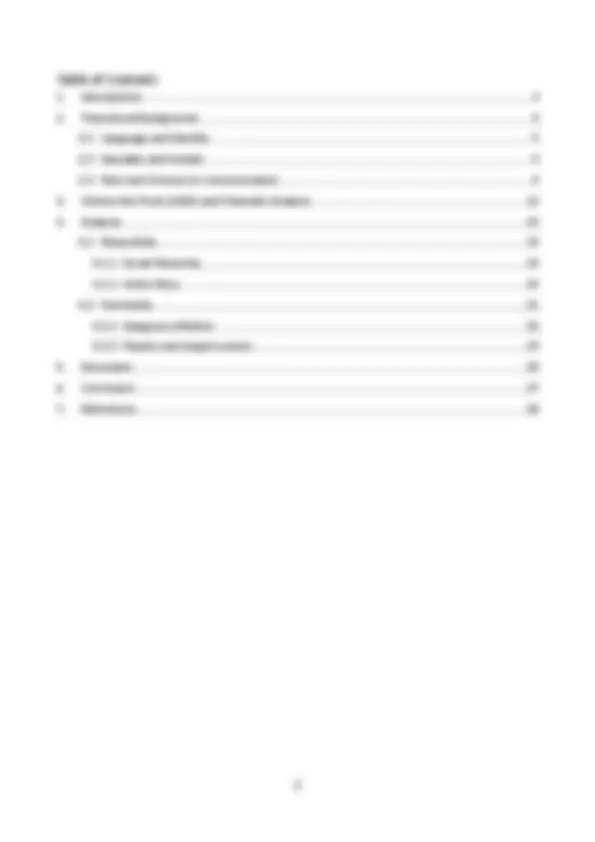
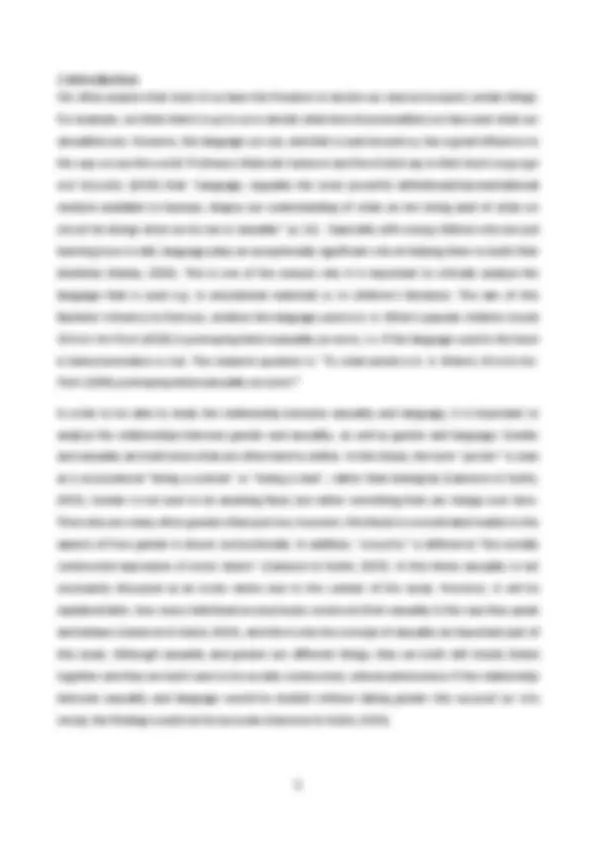
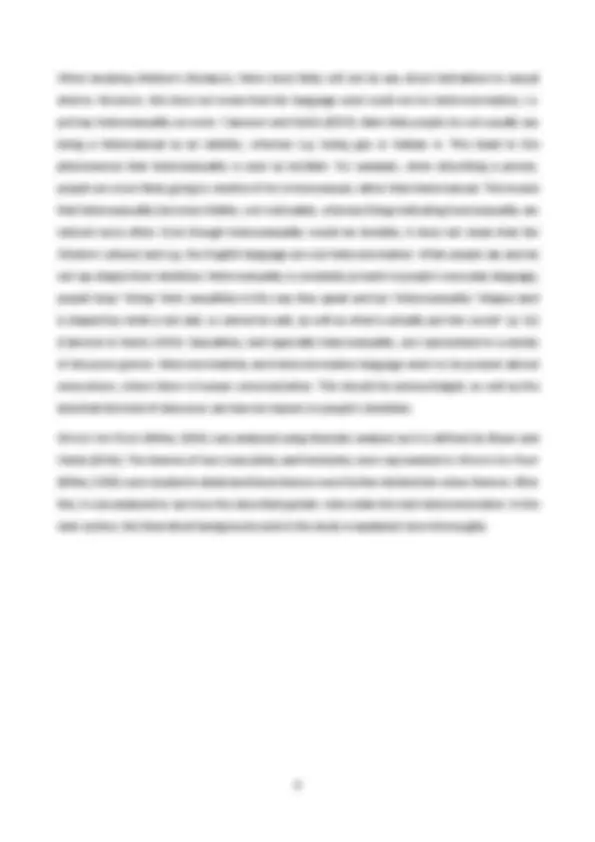
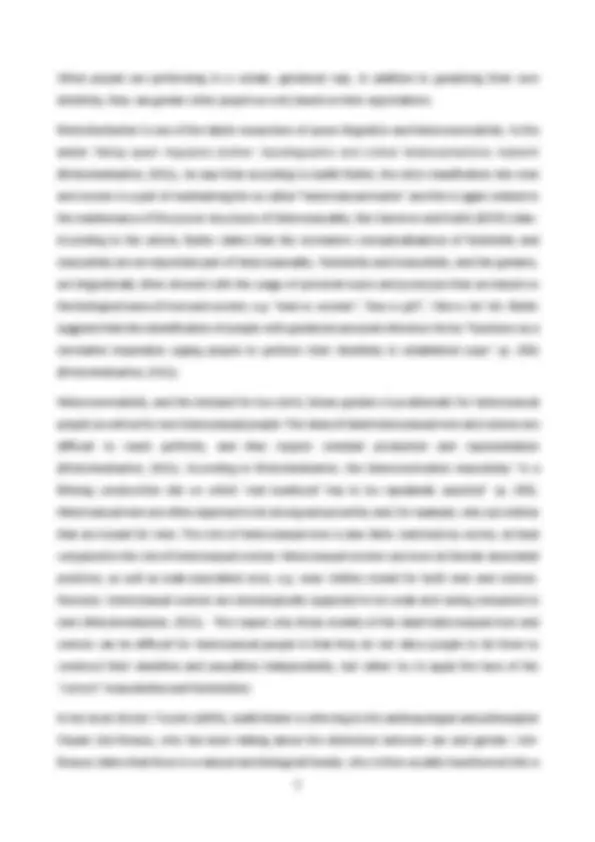
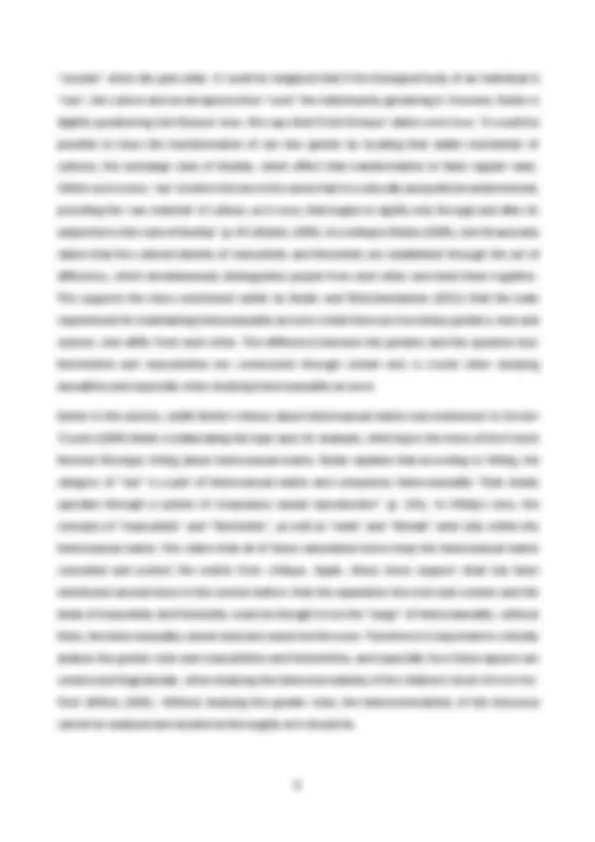
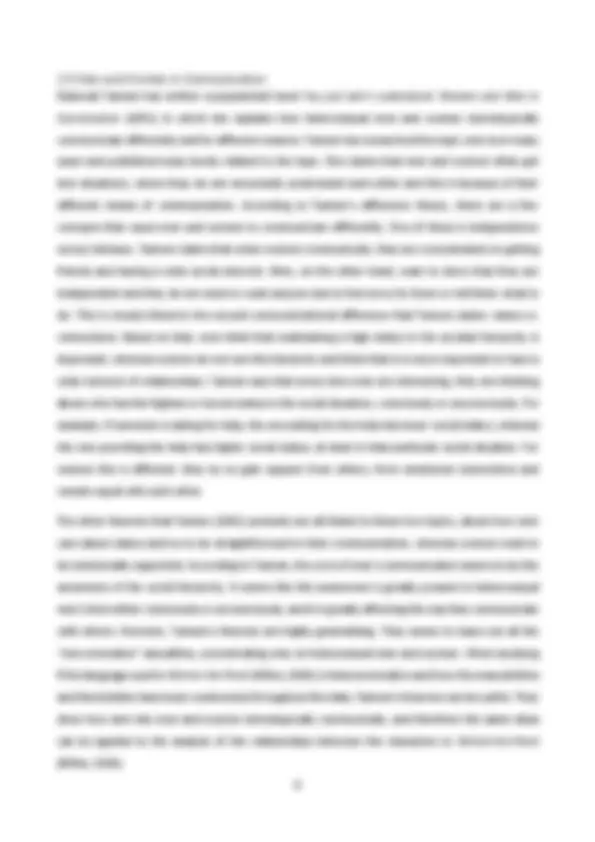
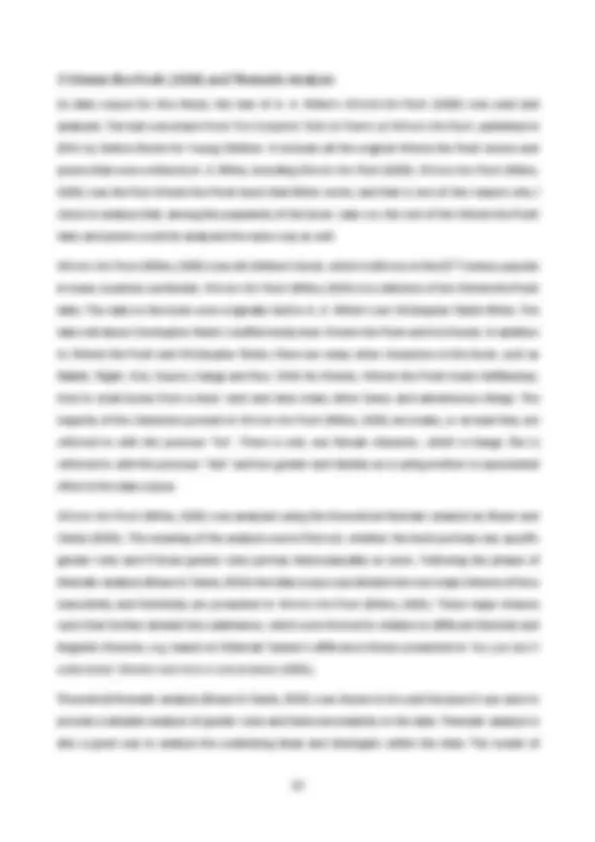
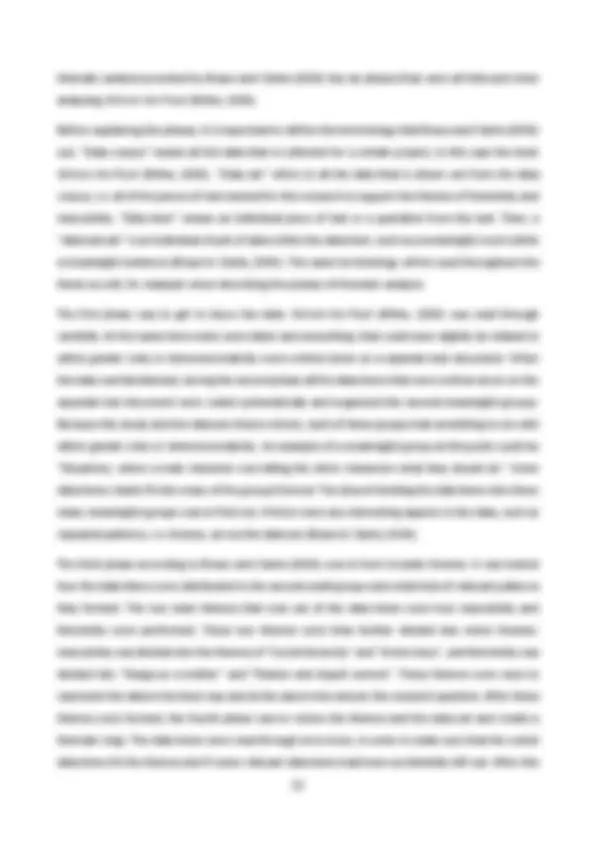
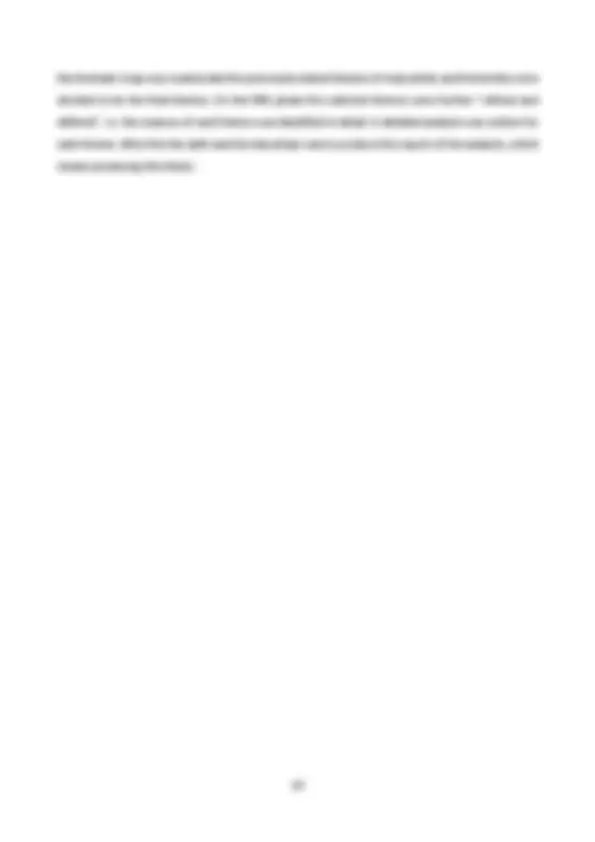
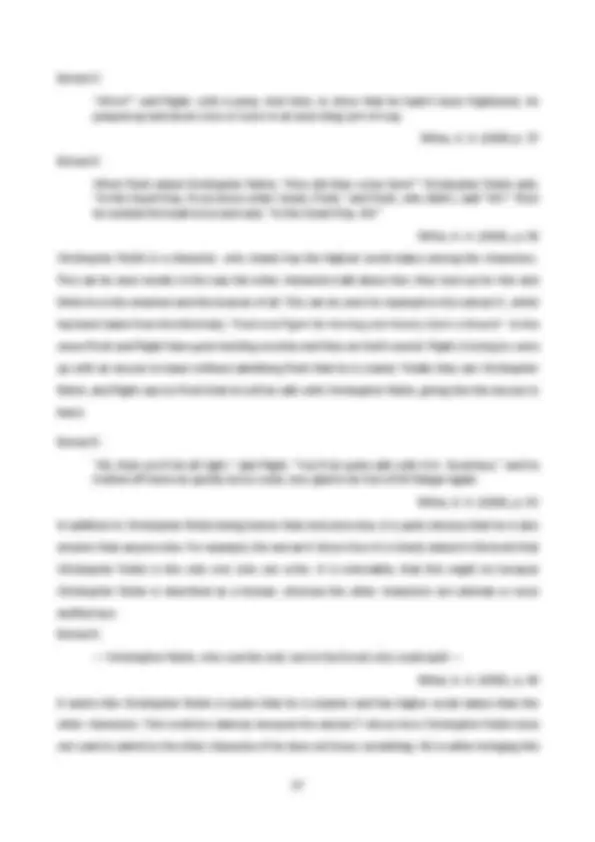
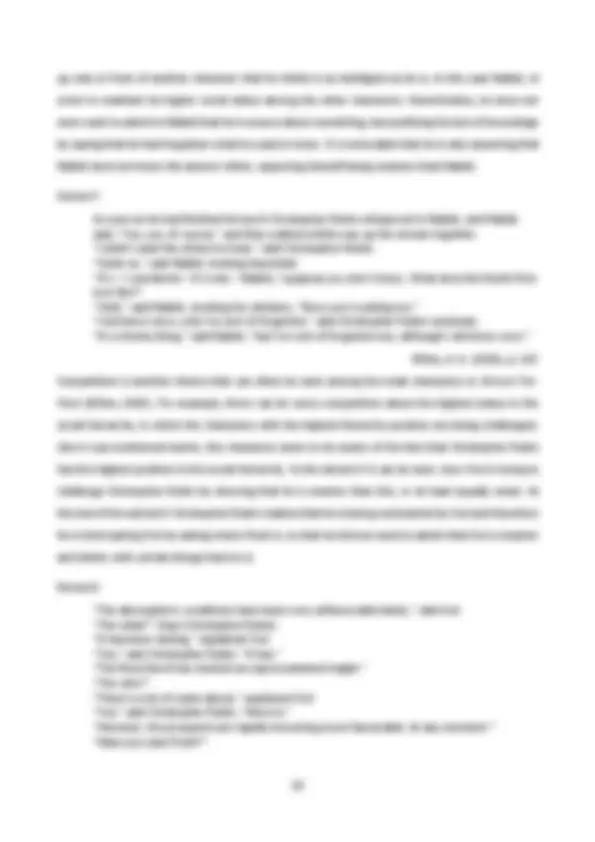
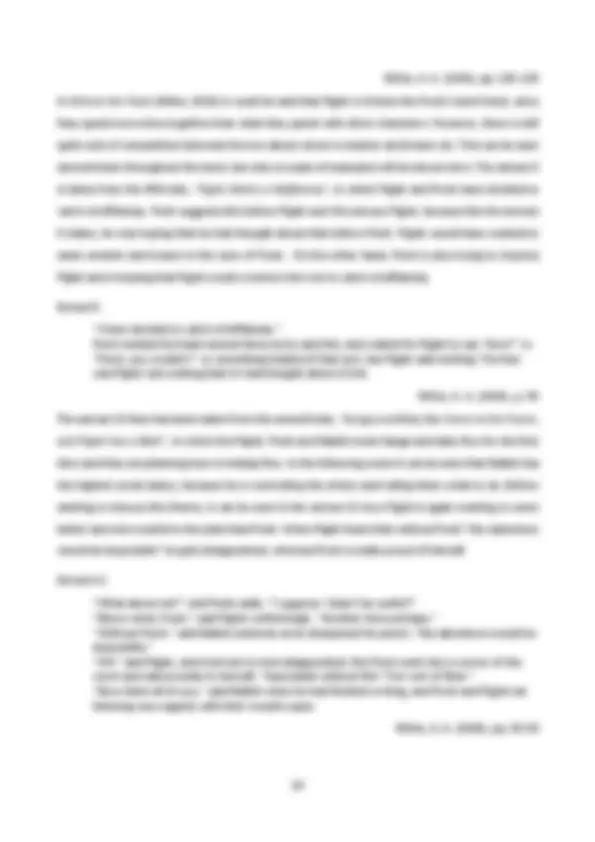
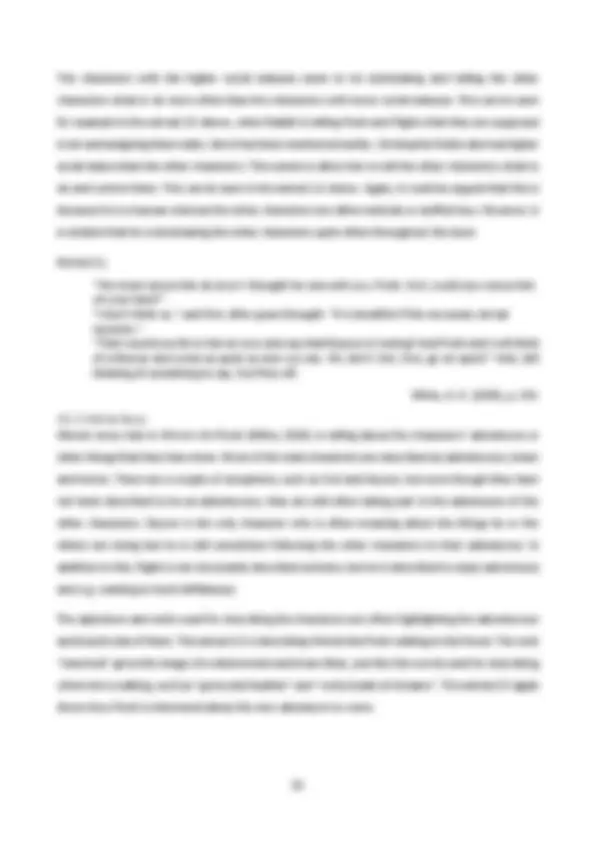
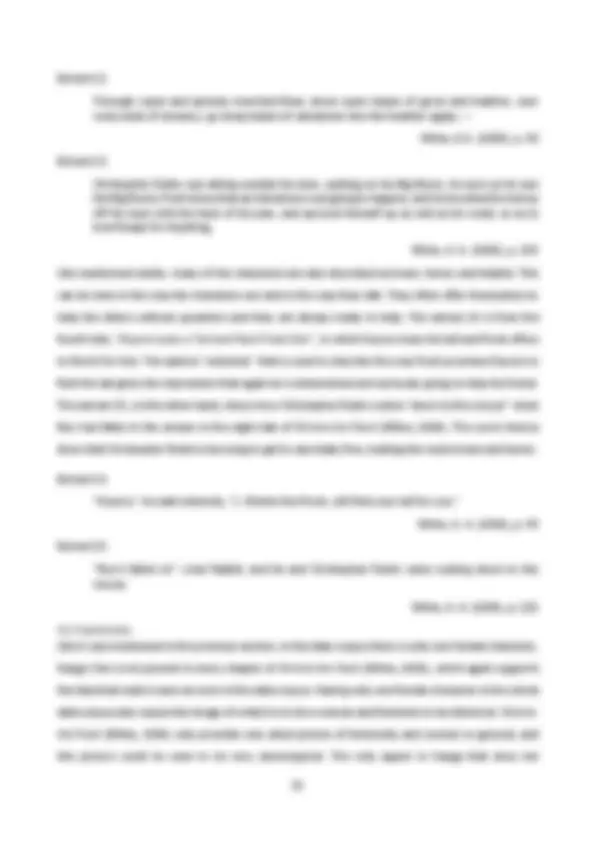
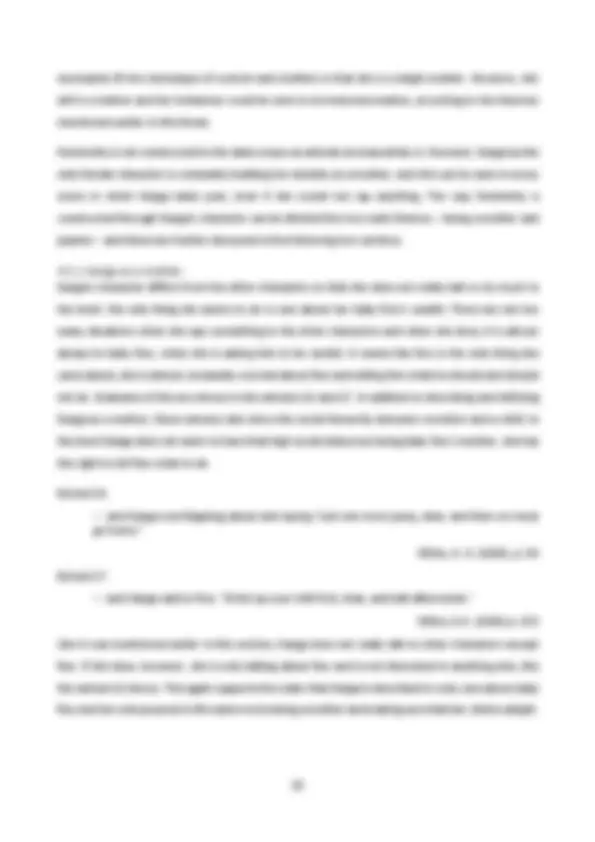
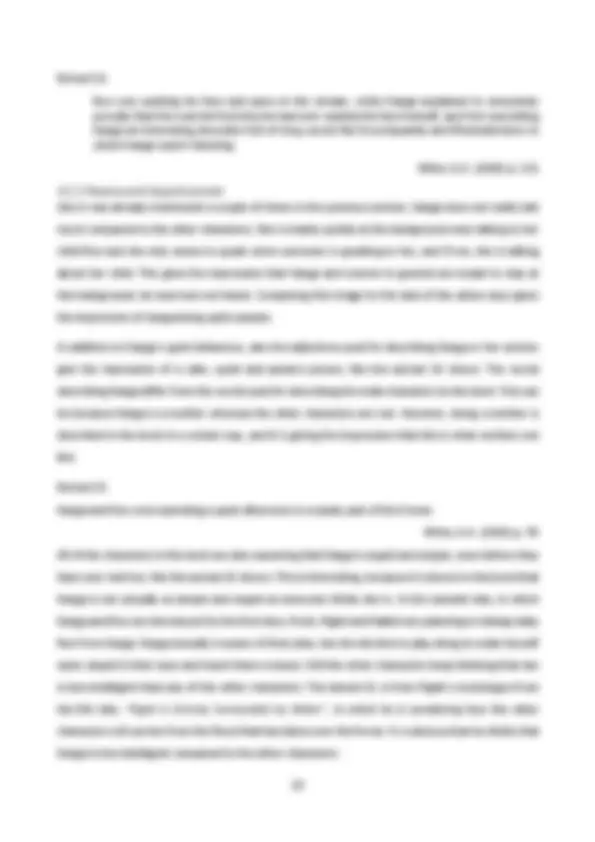
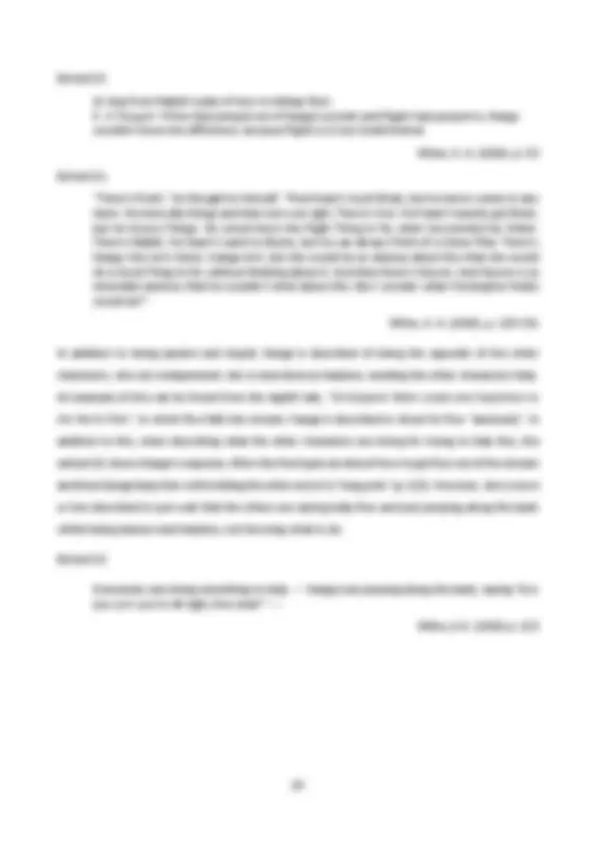
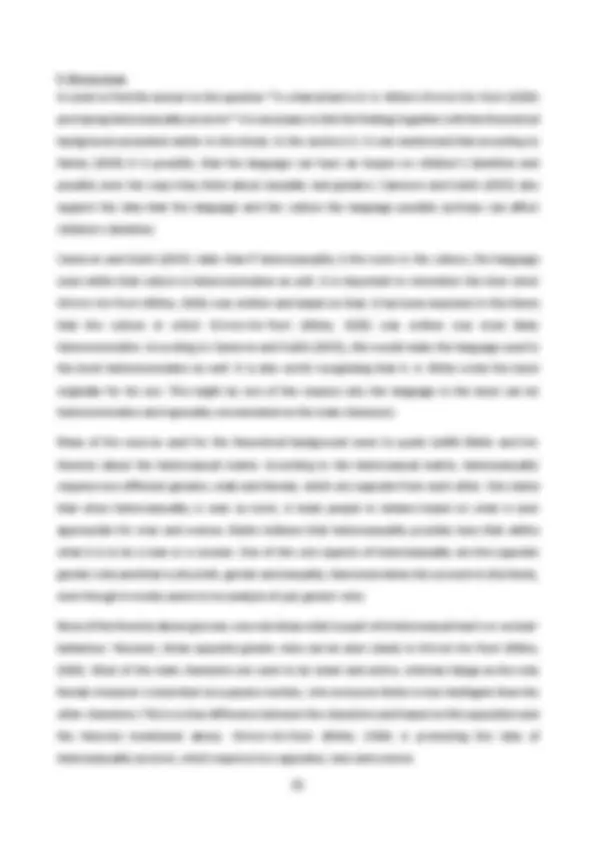
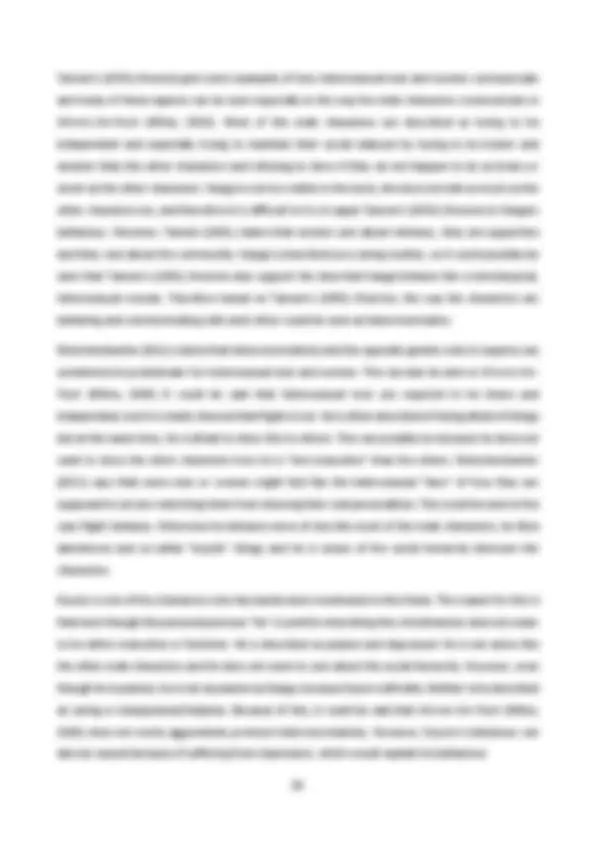
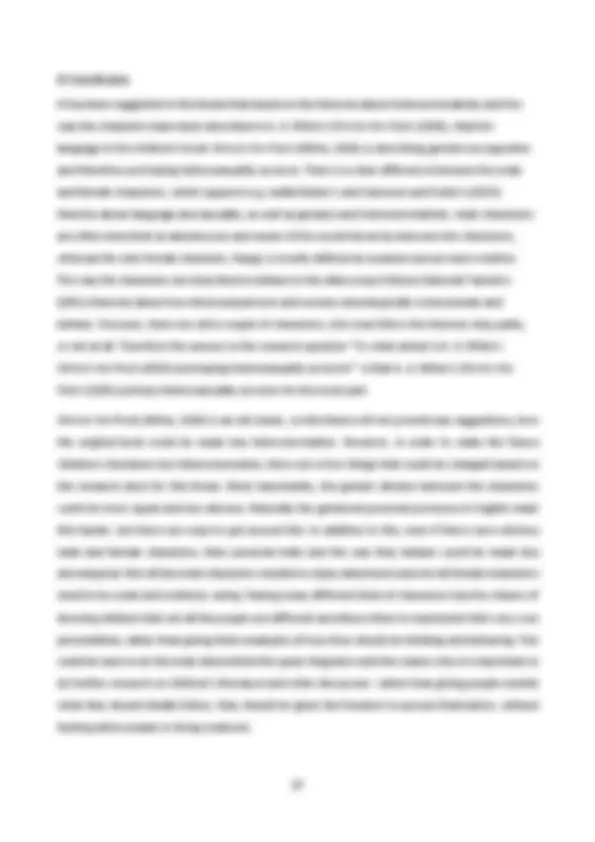
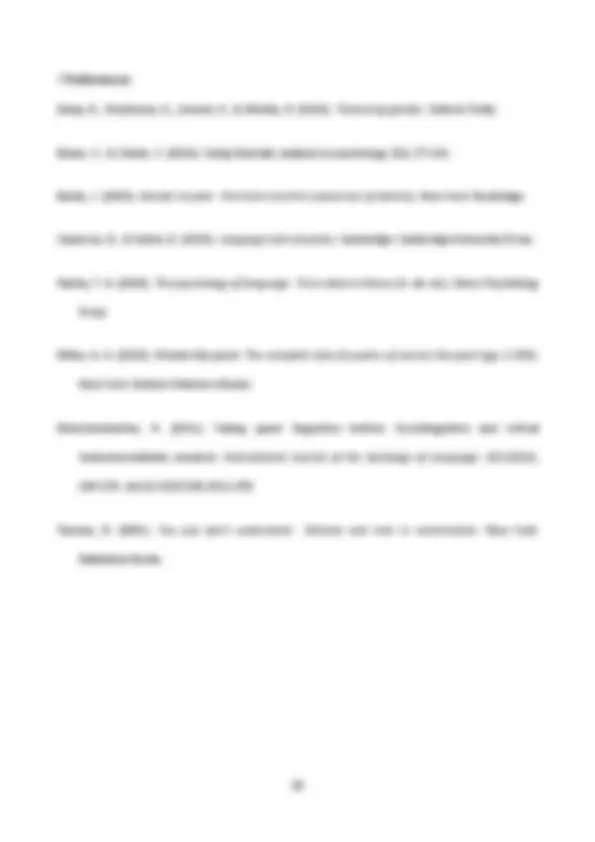


Study with the several resources on Docsity

Earn points by helping other students or get them with a premium plan


Prepare for your exams
Study with the several resources on Docsity

Earn points to download
Earn points by helping other students or get them with a premium plan
Community
Ask the community for help and clear up your study doubts
Discover the best universities in your country according to Docsity users
Free resources
Download our free guides on studying techniques, anxiety management strategies, and thesis advice from Docsity tutors
A Bachelor's thesis examining the portrayal of heterosexuality as norm and gender roles in A.A. Milne's popular children's book, Winnie-the-Pooh (1926). The research question is 'To what extent is A.A. Milne’s Winnie-the-Pooh (1926) portraying heterosexuality as norm?' The thesis explores how language, communication, and gender are represented in the book, drawing on theories by Judith Butler, Deborah Tannen, and others.
What you will learn
Typology: Study notes
1 / 29

This page cannot be seen from the preview
Don't miss anything!






















Tiina Eilittä 682285A Bachelor’s seminar and thesis English Philology Faculty of Humanities University of Oulu Autumn 2015
This thesis examines the heteronormativity and gender roles in A. A. Milne’s popular children’s book Winnie-the-Pooh (1926). The research question is “To what extent is A. A. Milne’s Winnie-the-Pooh (1926) portraying heterosexuality as norm?” Winnie-the-Pooh (Milne, 1926) was used as a data corpus and analysed using Braun and Clarke’s (2006) model of thematic analysis. One of the main themes examined was masculinity, which was further divided into themes such as social hierarchy and active boys. Another main theme was femininity, which examines Winnie-the-Pooh ’s (Milne,
We often assume that most of us have the freedom to decide our stances towards certain things. For example, we think that it is up to us to decide what kind of personalities we have and what our sexualities are. However, the language we use, and that is used around us, has a great influence to the way we see the world. Professors Deborah Cameron and Don Kulick say in their book Language and Sexuality (2006) that “Language, arguably the most powerful definitional/representational medium available to humans, shapes our understanding of what we are doing (and of what we should be doing) when we do sex or sexuality” (p. 12). Especially with young children who are just learning how to talk, language plays an exceptionally significant role at helping them to build their identities (Harley, 2008). This is one of the reasons why it is important to critically analyse the language that is used e.g. in educational materials or in children’s literature. The aim of this Bachelor’s thesis is to find out, whether the language used in A. A. Milne’s popular children’s book Winnie-the-Pooh (1926) is portraying heterosexuality as norm, i.e. if the language used in the book is heteronormative or not. The research question is: “To what extent is A. A. Milne’s Winnie-the- Pooh (1926) portraying heterosexuality as norm?”
In order to be able to study the relationship between sexuality and language, it is important to analyse the relationships between gender and sexuality, as well as gender and language. Gender and sexuality are both terms that are often hard to define. In this thesis, the term “ gender” is seen as a sociocultural “being a woman” or “being a man”, rather than biological (Cameron & Kulick, 2003). Gender is not seen to be anything fixed, but rather something that can change over time. There also are many other genders than just two; however, this thesis is concentrated mainly to the aspects of how gender is shown socioculturally. In addition, “ sexuality” is defined as “the socially constructed expression of erotic desire” (Cameron & Kulick, 2003). In this thesis sexuality is not necessarily discussed as an erotic desire due to the context of the study. However, it will be explained later, how every individual unconsciously constructs their sexuality in the way they speak and behave (Cameron & Kulick, 2003), and this is why the concept of sexuality an important part of this study. Although sexuality and gender are different things, they are both still closely linked together and they are both seen to be socially constructed, cultural phenomena. If the relationship between sexuality and language would be studied without taking gender into account (or vice versa), the findings would not be accurate (Cameron & Kulick, 2003).
When studying children’s literature, there most likely will not be any direct indications to sexual desires. However, this does not mean that the language used could not be heteronormative; i.e. portray heterosexuality as norm. Cameron and Kulick (2003) claim that people do not usually see being a heterosexual as an identity, whereas e.g. being gay or lesbian is. This leads to the phenomenon that heterosexuality is seen as invisible. For example, when describing a person, people are more likely going to mention if he is homosexual, rather than heterosexual. This means that heterosexuality becomes hidden, not noticeable, whereas things indicating homosexuality are noticed more often. Even though heterosexuality would be invisible, it does not mean that the Western cultures and e.g. the English language are not heteronormative. What people say and do not say shapes their identities. Heterosexuality is constantly present in people’s everyday language; people keep “doing” their sexualities in the way they speak and act. Heterosexuality “shapes (and is shaped by) what is not said, or cannot be said, as well as what is actually put into words” (p. 12) (Cameron & Kulick, 2003). Sexualities, and especially heterosexuality, are represented in a variety of discourse genres. Heteronormativity and heteronormative language seem to be present almost everywhere, where there is human communication. This should be acknowledged, as well as the idea that this kind of discourse can have an impact on people’s identities.
Winnie-the-Pooh (Milne, 1926) was analysed using thematic analysis as it is defined by Braun and Clarke (2006). The themes of how masculinity and femininity were represented in Winnie-the-Pooh (Milne, 1926) were studied in detail and these themes were further divided into minor themes. After this, it was analysed to see how the described gender roles make the text heteronormative. In the next section, the theoretical background used in the study is explained more thoroughly.
heterosexuality is seen to be the norm in the society and culture, then heterosexuality is the norm in our language as well, i.e. the language we use is heteronormative. People might often claim that people are naturally heterosexuals because of biological and reproductive reasons. However, Cameron and Kulick (2003) state that people do not let heterosexuality occur naturally. They claim that heterosexuality is “aggressively promoted in every part of the culture” (p. 44) and repeated over and over again until people believe that it is the norm. The society does not let people to decide about their sexualities on their own, which should be the case, if heterosexuality was naturally the norm.
Cameron and Kulick (2003) claim that heterosexuality is a political recognition, which requires opposites. There has to be a clear difference between men and women, but also a distinction between heterosexual and homosexual people. It is also claimed that heterosexuality is about power in one way or another, e.g. there is a power difference between men and women and between heterosexual and non-heterosexual people. Because of this power relation, it is important to analyse heterosexuality and heteronormativity critically. Neglecting to examine heterosexuality in different social contexts only reinforces its dominant status in the society. Cameron and Kulick’s (2003) claims about heterosexuality as norm are interesting, and because of these reasons it is important to analyse whether the language used in children’s literature could be heteronormative.
The book theorizing gender (Alsop, Fitzsimons, Lennon, & Minsky, 2002) contains an article Judith Butler: Queen of Queer , which explains that according to Judith Butler, people are divided into the different genders of men and women mainly because of heterosexuality. This restriction to two genders is crucial for compulsory heterosexuality, and this differentiation into male and female mainly serves the reproductive aims. When heterosexuality is seen as norm in general, it leads people to believe in gender roles; what it is to be a man or a woman. This connection between heterosexuality and gender roles is one of the reasons why it is important to study gender aspects as well when researching the relationship between language and sexuality. According to the article, Butler claims that people are not e.g. born to be women, but they rather become women because of the culture and society, that believe heterosexuality being the “normal” sexuality. This compulsory heterosexuality provides laws that give people the ideals of what kind of behaviour is appropriate for masculinity and femininity and what is not (Alsop et al., 2002). This can mean that when people perform, they are expected to make a difference between masculinity and femininity.
When people are performing in a certain, gendered way, in addition to gendering their own identities, they can gender other people as well, based on their expectations.
Motschenbacher is one of the latest researchers of queer linguistics and heteronormativity. In the article Taking queer linguistics further: Sociolinguistics and critical heteronormativity research (Motschenbacher, 2011), he says that according to Judith Butler, the strict classification into men and women is a part of maintaining the so called “heterosexual matrix” and this is again related to the maintenance of the power structures of heterosexuality, like Cameron and Kulick (2003) claim. According to the article, Butler claims that the normative conceptualisations of femininity and masculinity are an important part of heterosexuality. Femininity and masculinity, and the genders, are linguistically often showed with the usage of personal nouns and pronouns that are based on the biological sexes of men and women, e.g. “man vs. woman”, “boy vs. girl”, “she vs. he” etc. Butler suggests that this identification of people with gendered personal reference forms “functions as a normative imperative urging people to perform their identities in established ways” (p. 156) (Motschenbacher, 2011).
Heteronormativity, and the demand for two strict, binary genders is problematic for heterosexual people as well as for non-heterosexual people. The ideas of ideal heterosexual men and women are difficult to reach perfectly, and they require constant production and representation (Motschenbacher, 2011). According to Motschenbacher, the heteronormative masculinity “is a lifelong construction site on which ‘real manhood’ has to be repeatedly asserted” (p. 158). Heterosexual men are often expected to be strong and powerful, and, for example, only use clothes that are meant for men. The role of heterosexual men is also fairly restricted by norms, at least compared to the role of heterosexual women. Heterosexual women can more do female-associated practices, as well as male-associated ones, e.g. wear clothes meant for both men and women. However, heterosexual women are stereotypically supposed to be weak and caring compared to men (Motschenbacher, 2011). The reason why these models of the ideal heterosexual men and women can be difficult for heterosexual people is that they do not allow people to let them to construct their identities and sexualities independently, but rather try to apply the laws of the “correct” masculinities and femininities.
In her book Gender Trouble (1999), Judith Butler is referring to the anthropologist and philosopher Claude Lévi-Strauss, who has been talking about the distinction between sex and gender. Lévi- Strauss claims that there is a natural and biological female, who is then socially transformed into a
Deborah Tannen has written a popularised book You just don’t understand: Women and Men in Conversation (1991) in which she explains how heterosexual men and women stereotypically communicate differently and for different reasons. Tannen has researched the topic a lot over many years and published many books related to the topic. She claims that men and women often get into situations, where they do not necessarily understand each other and this is because of their different means of communication. According to Tannen’s difference theory, there are a few concepts that cause men and women to communicate differently. One of these is independence versus intimacy. Tannen claims that when women communicate, they are concentrated on getting friends and having a wide social network. Men, on the other hand, want to show that they are independent and they do not need or want anyone else to feel sorry for them or tell them what to do. This is closely linked to the second communicational difference that Tannen states: status vs. connections. Based on that, men think that maintaining a high status in the societal hierarchy is important, whereas women do not see this hierarchy and think that it is more important to have a wide network of relationships. Tannen says that every time men are interacting, they are thinking about who has the highest or lowest status in the social situation, consciously or unconsciously. For example, if someone is asking for help, the one asking for the help has lower social status, whereas the one providing the help has higher social status, at least in that particular social situation. For women this is different: they try to gain support from others, form emotional connections and remain equal with each other.
The other theories that Tannen (1991) presents are all linked to these two topics, about how men care about status and try to be straightforward in their communication, whereas women want to be emotionally supported. According to Tannen, the core of men’s communication seems to be the awareness of the social hierarchy. It seems like this awareness is greatly present in heterosexual men’s lives either consciously or unconsciously, and it is greatly affecting the way they communicate with others. However, Tannen’s theories are highly generalising. They seems to leave out all the “non-normative” sexualities, concentrating only on heterosexual men and women. When studying if the language used in Winnie-the-Pooh (Milne, 1926) is heteronormative and how the masculinities and femininities have been constructed throughout the data, Tannen’s theories can be useful. They show how and why men and women stereotypically communicate, and therefore the same ideas can be applied to the analysis of the relationships between the characters in Winnie-the-Pooh (Milne, 1926).
One chapter of You just don’t understand: Women and Men in Conversation (Tannen, 1991) explains that one of the reasons why men and women communicate differently is because they have been raised in different kinds of cultures. Tannen (1991) claims that first of all, adults tend to talk differently to girls than they talk to boys. They often also expect girls and boys to speak differently and this is when the people learn how they are supposed to talk. Secondly, peers can also have a great impact on the way the children learn to speak and behave. When children are playing in same- sex groups, boys usually play different kinds of games and use different kind of language compared to the girls. As an example, girls prefer playing in small groups with their best friends. They often have activities that do not involve having winners or losers, such as playing home or playing with dolls. Boys, on the other hand, like to play in bigger groups where they have some kind of hierarchy; they often have a leader, who tells the rest of the boys what should be done and how. Boys also more often play games that have both winners and losers, and they are often “heard to boast of their skill and argue who is best at what” (p. 43) (Tannen, 1991). According to Tannen (1991), living in these different cultures and playing different kinds of games with their peers is the reason why men and women tend to communicate differently when they are adults. If it is true that our childhood experiences affect our identities and the way we talk with other people, then it is important to find out if and how children’s literature is portraying certain kinds of world views.
According to Motschenbacher (2011), “linguistic manifestations of heteronormative discourses are, over wide stretches, identical with the linguistic construction of gender as a binary category, because where language constructs people as female and male, it also normatively implies opposite- gender relations” (p. 163). This idea of genders as each other’s opposites supports the normative conceptualisations of femininity and masculinity as important parts of heterosexuality, as it was mentioned earlier in the section 2.2. Motschenbacher (2011) refers to his earlier research from 2007 in which he is talking about the performative potential of the genders. He claims that in addition to commonly used gendered pronouns and nouns, there can be certain features that are stereotypically connected to either female of male speech behaviour. For example, women could be seen to use more adjectives and descriptive colours in their speech, whereas men stereotypically use more swear-words. This could be linked to the way Tannen (1991) explains that men and women communicate differently.
However, the idea of having stereotypical ways of speech behaviour and communication can be criticised as well. Moschenbacher (2011) himself says these features cannot necessarily be found
As data corpus for this thesis, the text of A. A. Milne’s Winnie-the-Pooh (1926) was used and analysed. The text was drawn from The Complete Tales & Poems of Winnie-the-Pooh , published in 2001 by Dutton Books for Young Children. It includes all the original Winnie the Pooh stories and poems that were written by A. A. Milne, including Winnie-the-Pooh (1926). Winnie-the-Pooh (Milne,
Winnie-the-Pooh (Milne, 1926) is an old children’s book, which is still now in the 21st^ Century popular in many countries worldwide. Winnie-the-Pooh (Milne, 1926) is a collection of ten Winnie the Pooh tales. The tales in the book were originally told to A. A. Milne’s son Christopher Robin Milne. The tales tell about Christopher Robin’s stuffed teddy bear Winnie the Pooh and his friends. In addition to Winnie the Pooh and Christopher Robin, there are many other characters in the book, such as Rabbit, Piglet, Owl, Eeyore, Kanga and Roo. With his friends, Winnie the Pooh hunts heffalumps, tries to steal honey from a bees’ nest and does many other funny and adventurous things. The majority of the characters present in Winnie-the-Pooh (Milne, 1926) are males, or at least they are referred to with the pronoun “he”. There is only one female character, which is Kanga. She is referred to with the pronoun “she” and her gender and identity as a caring mother is represented often in the data corpus.
Winnie-the-Pooh (Milne, 1926) was analysed using the theoretical thematic analysis by Braun and Clarke (2006). The meaning of the analysis was to find out, whether the book portrays any specific gender roles and if those gender roles portray heterosexuality as norm. Following the phases of thematic analysis (Braun & Clarke, 2006) the data corpus was divided into two major themes of how masculinity and femininity are presented in Winnie-the-Pooh (Milne, 1926). These major themes were then further divided into subthemes, which were formed in relation to different feminist and linguistic theories, e.g. based on Deborah Tannen’s difference theory presented in You just don’t understand: Women and men in conversation (1991).
Theoretical thematic analysis (Braun & Clarke, 2006) was chosen to be used because it was seen to provide a detailed analysis of gender roles and heteronormativity in the data. Thematic analysis is also a good way to analyse the underlying ideas and ideologies within the data. The model of
thematic analysis provided by Braun and Clarke (2006) has six phases that were all followed when analysing Winnie-the-Pooh (Milne, 1926).
Before explaining the phases, it is important to define the terminology that Braun and Clarke (2006) use. “Data corpus” means all the data that is collected for a certain project, in this case the book Winnie-the-Pooh (Milne, 1926). “Data set” refers to all the data that is drawn out from the data corpus, i.e. all of the pieces of text needed for this research to support the themes of femininity and masculinity. “Data item” means an individual piece of text or a quotation from the text. Then, a “data extract” is an individual chunk of data within the data item, such as a meaningful word within a meaningful sentence (Braun & Clarke, 2006). The same terminology will be used throughout this thesis as well, for example when describing the phases of thematic analysis.
The first phase was to get to know the data. Winnie-the-Pooh (Milne, 1926) was read through carefully. At the same time notes were taken and everything, that could even slightly be related to either gender roles or heteronormativity were written down on a separate text document. When the data was familiarised, during the second phase all the data items that were written down on the separate text document were coded systematically and organised into several meaningful groups. Because this study and the data are theory-driven, each of these groups had something to do with either gender roles or heteronormativity. An example of a meaningful group at this point could be “Situations, where a male character was telling the other characters what they should do”. Some data items clearly fit into many of the groups formed. The idea of dividing the data items into these many meaningful groups was to find out, if there were any interesting aspects in the data, such as repeated patterns, i.e. themes, across the data set (Braun & Clarke, 2006).
The third phase according to Braun and Clarke (2006) was to form broader themes. It was looked how the data items were distributed to the several small groups and what kind of relevant patterns they formed. The two main themes that rose out of the data items were how masculinity and femininity were performed. These two themes were then further divided into minor themes: masculinity was divided into the themes of “Social hierarchy” and “Active boys”, and femininity was divided into “Kanga as a mother” and “Passive and stupid women”. These themes were seen to represent the data in the best way and at the same time answer the research question. After these themes were formed, the fourth phase was to review the themes and the data set and create a thematic map. The data items were read through once more, in order to make sure that the coded data items fit the themes and if some relevant data items had been accidentally left out. After this
In this section, the analysis of the data and the findings will be explained in detail. When reading the analysis, it is important to note that when talking about masculinity and femininity and mentioning certain characters being male or female, it does not refer to their “biological” genders, but rather to the way the characters are described to act socioculturally. Often in the media the genders of certain characters have been argued about, but the genders of the characters claimed in this thesis are based on the way the characters were described in the data corpus and how they follow the theories of masculinities and femininities mentioned earlier in the section 2.
The analysis has been divided into two main themes: masculinity and femininity. These main themes have then been further divided into subthemes: masculinity – section consists of the subthemes of Social Hierarchy and Active Boys, whereas the femininity – section is further divided into Kanga as mother and Passive and Stupid Women. Examples and extracts from the data corpus will be provided alongside the analysis.
Masculinity and what it is to be a boy are continuously constructed throughout the data corpus. This is visible in the way the characters and the milieu are described, as well as in the characters’ behaviour and the way they are described to communicate with each other. Winnie-the-Pooh (Milne, 1926) has overall eight main characters; Winnie the Pooh, Christopher Robin, Piglet, Rabbit, Owl, Eeyore, Kanga and Roo. Seven of these are described to be male characters. This can be seen in the pronouns that are used for describing them (he/him/his), but also in the way the characters act and talk. This unequal division between the male and female characters supports the idea that in Winnie-the-Pooh (Milne, 1926), male is seen as norm. All of the male characters are actively building their masculinity throughout the data corpus, and in the following sections the two main themes and actions of constructing masculinity among the characters will be discussed.
Tannen (1991) claims that every time men are interacting with each other, they are aware of the social hierarchy between the people. She claims that there are a couple of aspects that men value, and which cause men to communicate and behave the way they do. The first aspect Tannen mentions is independence: it is important for men to seem independent and decide over one’s own life. This can also be seen in Winnie-the-Pooh (Milne, 1926). A good example of this can be found from the second tale in the book, called “ Pooh Goes Visiting and Gets Into a Tight Place” , in which
Winnie the Pooh visits his friend Rabbit’s place and whilst being there, eats some honey and condensed milk with bread. When is Pooh’s time to leave, he has got bigger because of eating and he gets stuck to the Rabbit’s doorway. He does not want to admit that he got stuck and even when Rabbit offers to help him, he refuses to admit that he is in trouble. The extract 1 below shows, how Pooh is trying to remain independent. The text inside the square brackets is added just for this analysis:
Extract 1. “Hallo, are you stuck?” he [Rabbit] asked. “N-no,” said Pooh carelessly. “Just resting and thinking and humming to myself.” Milne, A. A. (1926), p. 26 Later on in the same tale, Pooh’s behaviour also supports other theories that Tannen has claimed about men’s behaviour. In the extract 2, Pooh is trying to maintain his status in the social hierarchy. When Rabbit comes and tries to pull Pooh out of his doorway, Pooh does not want to admit that it was his own fault that he got stuck in the doorway. He is trying to blame others and he even blames Rabbit’s doorway. Admitting the mistake would possibly make Pooh seem less smart in the eyes of Rabbit and make Rabbit seem “better” than Pooh, positioning Pooh to a one-down position compared to Rabbit. According to Tannen (1991) men try to avoid this, just like Pooh in the extract
Extract 2. “It all comes,” said Pooh crossly, “of not having front doors big enough.” Milne, A. A. (1926), p. 26 Trying to maintain one’s social status and trying to seem better than others can be constantly seen in the way the male characters act. Many characters try to seem either smarter, braver or better in some other ways compared to each other. The other phenomena is that they may not want to show it to others if they do not know about something or if they are scared. The extract 3 shows how Piglet is trying to hide it from the other characters that he got frightened. On the other hand, in the extract 4 Pooh is asking Christopher Robin how Kanga and Roo came to the Forest. Christopher Robin does not necessarily know how to answer Pooh’s question, so he just says “In the Usual Way” and after Pooh, who still does not understand how, claims to understand, because he does not want to ask again or seem stupid in the eyes of Christopher Robin.
up only in front of another character that he thinks is as intelligent as he is, in this case Rabbit, in order to maintain his higher social status among the other characters. Nevertheless, he does not even want to admit to Rabbit that he is unsure about something, but justifying his lack of knowledge by saying that he had forgotten what he used to know. It is noticeable that he is also assuming that Rabbit does not know the answer either, expecting himself being smarter than Rabbit.
Extract 7. As soon as he had finished his lunch Christopher Robin whispered to Rabbit, and Rabbit said, “Yes, yes, of course,” and they walked a little way up the stream together. “I didn’t want the others to hear,” said Christopher Robin. “Quite so,” said Rabbit, looking important. “It’s – I wondered – It’s only – Rabbit, I suppose you don’t know, What does the North Pole look like?” “Well,” said Rabbit, stroking his whiskers, “Now you’re asking me.” “I did know once, only I’ve sort of forgotten,” said Christopher Robin carelessly. “It’s a funny thing,” said Rabbit, “but I’ve sort of forgotten too, although I did know once .” Milne, A. A. (1926), p. 120 Competition is another theme that can often be seen among the male characters in Winnie-The- Pooh (Milne, 1926). For example, there can be some competition about the highest status in the social hierarchy, in which the characters with the highest hierarchy position are being challenged. Like it was mentioned earlier, the characters seem to be aware of the fact that Christopher Robin has the highest position in the social hierarchy. In the extract 8 it can be seen, how Owl is trying to challenge Christopher Robin by showing that he is smarter than him, or at least equally smart. At the end of the extract 8 Christopher Robin realises that he is being outsmarted by Owl and therefore he is interrupting Owl by asking where Pooh is, so that he did not need to admit that Owl is smarter and better with certain things than he is.
Extract 8. “The atmospheric conditions have been very unfavourable lately,” said Owl. “The what?” [Says Christopher Robin] “It has been raining,” explained Owl. “Yes,” said Christopher Robin. “It has.” “The flood-level has reached an unprecedented height.” “The who?” “There’s a lot of water about,” explained Owl. “Yes,” said Christopher Robin, “there is.” “However, the prospects are rapidly becoming more favourable. At any moment–” “Have you seen Pooh?”
Milne, A. A. (1926), pp. 138- In Winnie-the-Pooh (Milne, 1926) it could be said that Piglet is Winnie the Pooh’s best friend, since they spend more time together than what they spend with other characters. However, there is still quite a lot of competition between the two about whom is smarter and braver etc. This can be seen several times throughout the book, but only a couple of examples will be shown here. The extract 9 is taken from the fifth tale, “Piglet Meets a Heffalump” , in which Piglet and Pooh have decided to catch a heffalump. Pooh suggests this before Piglet and this annoys Piglet, because like the extract 9 states, he was hoping that he had thought about that before Pooh. Piglet would have wanted to seem smarter and braver in the eyes of Pooh. On the other hand, Pooh is also trying to impress Piglet and is hoping that Piglet would convince him not to catch a heffalump.
Extract 9. “I have decided to catch a Heffalump.” Pooh nodded his head several times as he said this, and waited for Piglet to say “How?” or “Pooh, you couldn’t!” or something helpful of that sort, but Piglet said nothing. The fact was Piglet was wishing that he had thought about it first. Milne, A. A. (1926), p. 56 The extract 10 then has been taken from the seventh tale, “Kanga and Baby Roo Come to the Forest, and Piglet Has a Bath” , in which the Piglet, Pooh and Rabbit meet Kanga and baby Roo for the first time and they are planning how to kidnap Roo. In the following scene it can be seen that Rabbit has the highest social status, because he is controlling the others and telling them what to do. Before starting to discuss this theme, it can be seen in the extract 10 how Piglet is again wanting to seem better and more useful to the plan than Pooh. When Piglet hears that without Pooh “the adventure would be impossible” he gets disappointed, whereas Pooh is really proud of himself.
Extract 10. “What about me?” said Pooh sadly. “I suppose I shan’t be useful?” “Never mind, Pooh,” said Piglet comfortingly. “Another time perhaps.” “Without Pooh,” said Rabbit solemnly as he sharpened his pencil, “the adventure would be impossible.” “Oh!” said Piglet, and tried not to look disappointed. But Pooh went into a corner of the room and said proudly to himself, “Impossible without Me! That sort of Bear.” “Now listen all of you,” said Rabbit when he had finished writing, and Pooh and Piglet sat listening very eagerly with their mouths open. Milne, A. A. (1926), pp. 92-